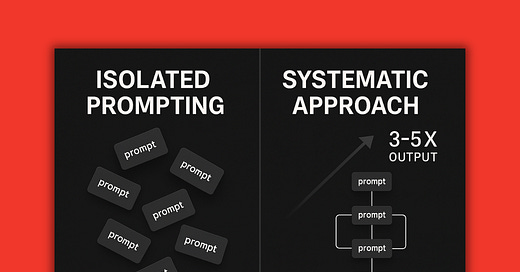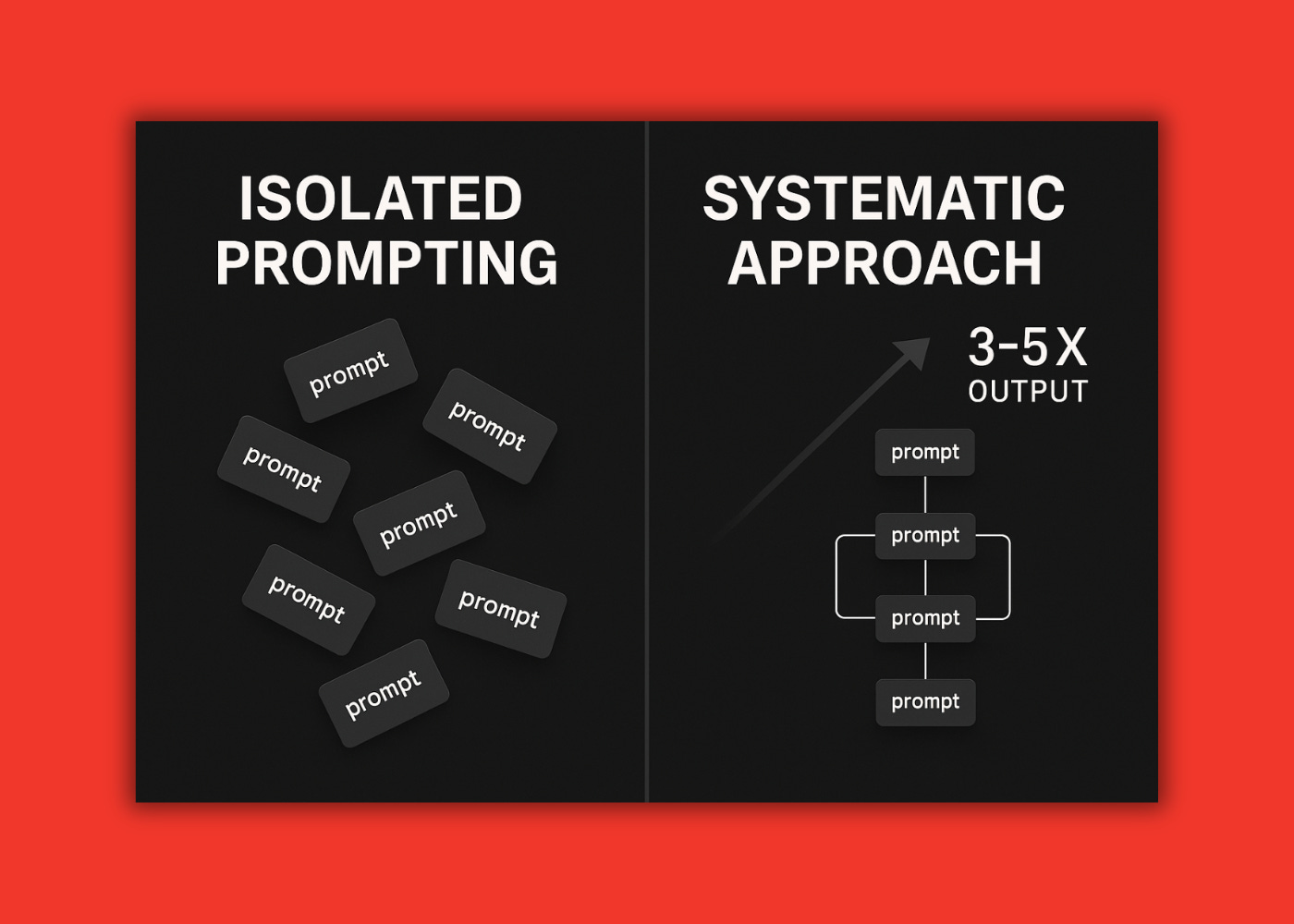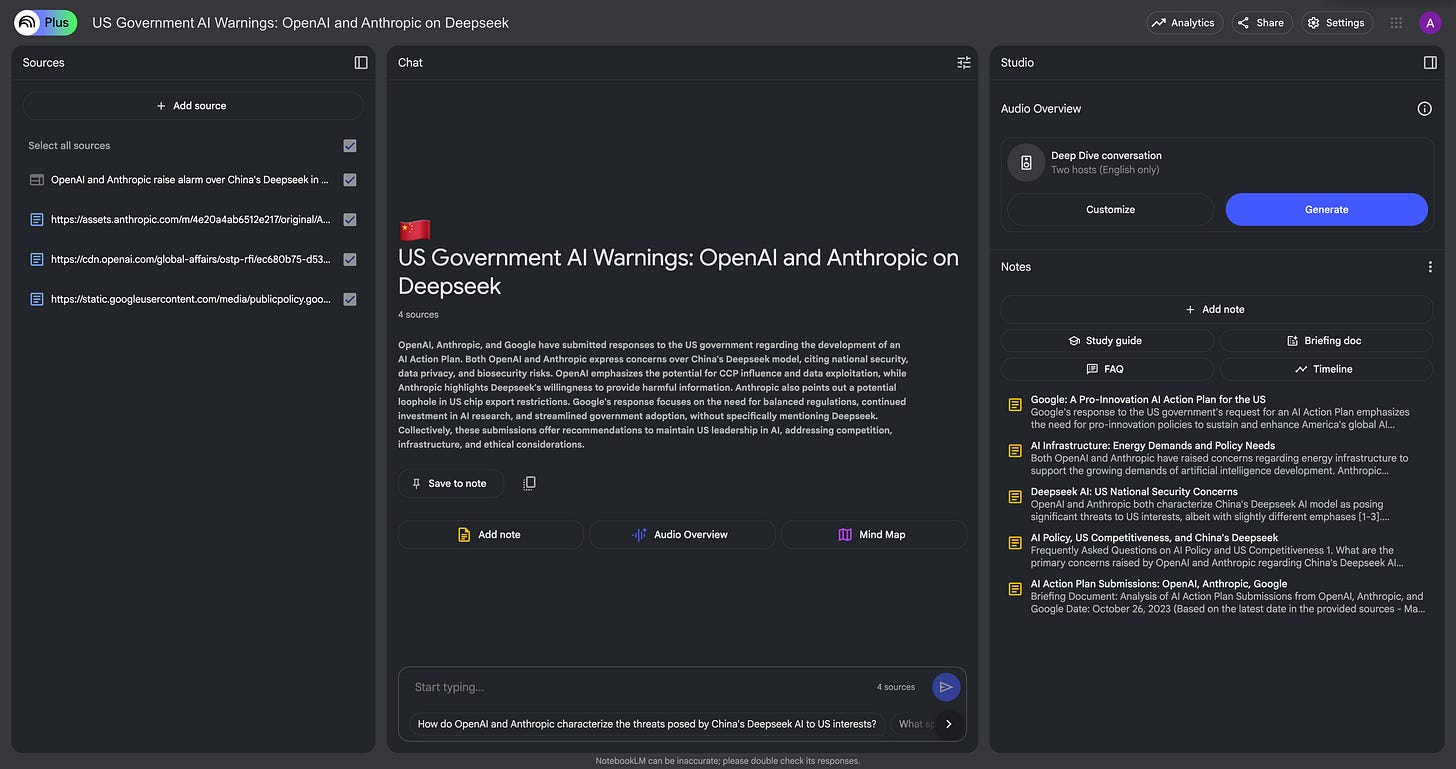Why isolated AI prompting is dead—and what's replacing it
As content demands and competition skyrocket, the difference between systematic and isolated AI use becomes stark.
→ Want my proven prompt systems? Get lifetime access to my personal Prompt Vault – a constantly updated Notion database with the exact prompts + knowledge docs I use for writing, research, and content creation.
Brands once planned content calendars in weeks, they now operate in days or even hours. Social platforms demand constant engagement, newsletters need consistent value delivery, and business communications require fast turnaround with impeccable quality.
AI tools promised to solve this problem – but they also created a new one in the process.
The market is now flooded with AI-generated content, most of it mediocre at best. This content tsunami has two significant consequences: audiences have become more discerning, and the gap between professionals using structured AI systems and those relying on random prompting has widened dramatically.
The problem with random prompting
Most AI writing advice falls into two problematic categories:
Basic prompt collections with no systematic implementation
Theoretical discussions from people who don't produce content with AI
The problem with prompt collections is simple: they're isolated tools without context. It's like having a set of specialized surgical instruments without knowing the procedures they're designed for.
Random prompting creates several critical problems:
Inconsistent outputs requiring extensive editing
Time wasted in trial-and-error experimentation
No scalable process for teams or high-volume work
Inability to replicate success when you do get a good result
Why systematic approaches matter more than ever
In 2025, three factors have converged to make systems essential:
1. Unprecedented content volume requirements
The average business or individual brand now produces way more content than it did in 2023. This isn't optional – it's the baseline for remaining competitive.
2. Rising audience quality expectations
Content consumers can spot (bad) AI-generated material immediately – unless it's produced using content systems that incorporate human expertise, fact-checking, and brand voice consistency.
3. Efficiency demands for content creators
Writers, marketers, and communicators are expected to produce more quality with less time. Without systems, this is simply impossible.
As content demands increase and AI evolves, the gap between systematic users and random prompters widens daily. What was once a small advantage has become an unbridgeable chasm.
Four critical areas where systems outperform random prompting
AI writing and research systems focus on measurable outcomes across four critical areas:
1. Content production acceleration
Systems compress the writing process without sacrificing quality or voice consistency. A properly designed system doesn't just make content faster – it makes it better.
These frameworks eliminate redundant steps, automate routine aspects of content creation, and optimize human input for maximum impact. Many creators and brands using systems like myself report 3-5x increases in output while maintaining or improving quality.
2. Research depth and efficiency
Finding, synthesizing, and analyzing information has traditionally been the most time-consuming part of content creation.
Systematic approaches transform this process, with methods to gather and synthesize information in minutes instead of hours. The key difference isn't just using AI for research – it's creating structured workflows that move seamlessly from research to writing to fact-checking.
3. Model-specific implementation
Different AI models have unique strengths and weaknesses. Users with systems don't just know which model to use – they have optimized workflows for each model's specific capabilities.
This includes understanding how to:
Structure prompts differently for each model
Combine models for different parts of the content creation process
Use model-specific features that casual users often overlook
4. Strategic integration
The most powerful systems seamlessly incorporate AI into existing content operations. These approaches connect AI tools with human expertise at precisely the right points in the process.
Random prompting treats AI as a replacement for human work. Systems treat AI as a strategic amplifier of human capability.
The measurable difference
The impact of implementing professional AI writing systems is immediate and substantial:
Output increases of 3-5x without additional human resources
Quality improvements measured by engagement, conversions, and audience growth
Time savings of 40-70% on routine content tasks
Getting started with AI writing systems
Shifting from random prompting to systematic approaches requires a fundamental mindset change. Instead of asking "What prompt should I use?" start asking:
"What specific outcome am I trying to achieve?"
"What repeatable process will consistently deliver this outcome?"
"How can I measure and improve this process over time?"
By asking questions like these, you can start to learn which tools and workflows should be paired together.
The future belongs to systems users
Looking ahead, one thing is clear: the advantage that systems provide will only increase. As AI models become more powerful, the difference between strategic and random usage will become even more apparent.
Those who develop systematic approaches to AI writing and research now will build an increasingly insurmountable advantage over the coming years. The gap we see today is just the beginning.
The most valuable skill in content creation is no longer just writing well—it's designing and implementing systems that deliver consistent, high-quality outputs at scale.






I really like this --> "Those who develop systematic approaches to AI writing and research now will build an increasingly insurmountable advantage over the coming years. The gap we see today is just the beginning." I'm starting to similar themes n cybersecurity as well. In fact, I just started writing about what I'm observing last week. Interesting times..
Add to the mix AI driven Cybersecurity gatekeepers and AI driven content summarizers and blocking gatekeepers in downstream channels and visibility and attribution of IP rights and rewards and……. mind boggling….. But AI……. (fill in the blank)😎